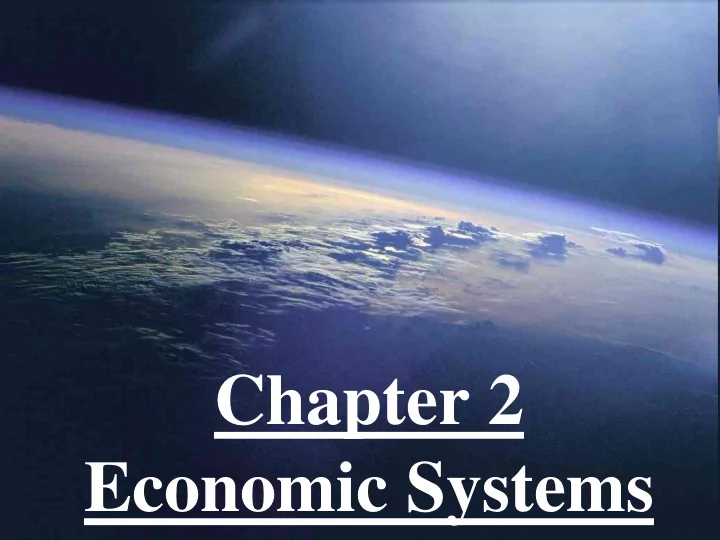

Chapter 2 Economic Systems
Economic Systems Section 1 – Answering the Three Economic Questions
The Three Key Economic Questions 1. What goods and services should be produced? 2. How should these goods and services be produced? 3. Who consumes these goods and services?
The Economic Questions are answered based on societies goals and values
Economic Goals and Societal Values
1. Economic Efficiency • Making the most of resources
2. Economic Freedom • Freedom from government intervention in the production and distribution of goods and services.
3. Economic Security and Predictability • Assurance that goods and services will be available, payments will be made on time, and a safety net will protect individuals in times of economic disaster
4. Economic Equity • Fair distribution of wealth
5. Economic Growth and Innovation • Innovation leads to economic growth, and economic growth leads to a higher standard of living.
6. Other Goals • Societies pursue additional goals, such as environmental protection.
Economic Systems • Economic System - the method used by a society to produce and distribute goods and services.
E.S. #1 – Traditional Economics • These economies rely on habit, custom, or ritual to decide what to produce, how to produce it, and to whom to distribute it.
E.S. #2 – Market Economies • economic decisions are made by individuals and are based on exchange, or trade.
E.S. #3 – Centrally Planned Economies • The central government makes all decisions about the production and consumption of goods and services.
E.S. #4 – Mixed Economies • These are systems that combine tradition and the free market with limited government intervention.
Economic Systems Section 2 – The Free Market
Why do Markets Exist? • Because none of us produces all the goods and services we require to satisfy our needs and wants.
Market - • Is an arrangement that allows buyers and sellers to exchange goods and services
Specialization- • Is the concentration of the productive efforts of individuals and forms on a limited number of activities.
Free Market Economy • Households and business firms use markets to exchange money and products.
Free Market - Motivation • Self-interest- the buyer and seller consider only their own personal gain.
Free Market - Regulation • Competition - producers in a free market struggle for the dollars of consumers
Free Market – Invisible Hand • The interaction of buyers and sellers, motivated by self- interest and regulated by competition, all happens without a central plan.
Free Market Advantages: 1. Economic Efficiency - as a self-regulating system, a free market economy is efficient.
2. Economic Freedom - Free market economies have the highest degree of economic freedom of any economic system.
3. Economic Growth - Because competition encourages innovation, free markets encourage growth.
4. Additional Goals - Free markets offer a wider variety of goods and services than any other economic system.
Economic Systems Section 3 – Centrally Planned Economies
Centrally Planned Economy • The government owns both land and capital. • The government decides what to produce, how much to produce, and how much to charge.
Example: Socialism • Socialism is a social and political philosophy based on the belief that democratic means should be used to distribute wealth evenly throughout a society.
Example: Communism • Communism is a political system characterized by a centrally planned economy with all economic and political power resting in the hands of the government.
Communism Example: Former Soviet Union • Soviet Agriculture – In the Soviet Union, the government created large state-owned farms and collectives for most of the country’s agricultural production.
Communism Example: Former Soviet Union • Soviet Industry – Soviet planners favored heavy-industry production (such as steel and machinery), over the production of consumer goods.
Communism Example: Former Soviet Union • Soviet Consumers – Consumer goods in the Soviet Union were scarce and usually of poor quality.
Centrally Planned Economics: Problems • poor-quality goods • shortages • diminishing production
Section 4 – Modern Economies Economic Systems
Modern Economies • Governments create laws protecting property rights and enforcing contracts. • Innovation is encouraged through patent laws.
Laissez faire • Doctrine that government generally should not interfere in the marketplace.
Comparing Mixed Economies Continuum of Mixed Economies Centrally planned Free market Iran South Africa France United Kingdom Hong Kong North Korea China Botswana Canada Singapore Cuba Russia Greece Peru United States Source: 1999 Index of Economic Freedom , Bryan T. Johnson, Kim R. Holmes, and Melanie Kirkpatrick
CH 2 Review Questions 1. Explain how a factory assembly line is an example of specialization. 2. Why are there no pure free markets in the world? 3. Think of three ways your life would change if the U.S. were a pure free market system. 4. List 2 advantages and 2 disadvantages to a free market system. 5.Suppose your household was its own nation. How would you answer the three key economic questions? (Centrally planned vs free market?)
Recommend
More recommend